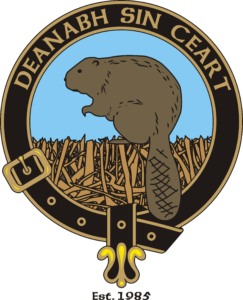Skyland: A Tale of Two Teams
On the morning of Sunday September 8th, Cardigan Highlanders met at the crossroads known as Alexandria Four Corners to work on the far southeastern end of Mount Cardigan's Skyland Trail. There was a lot of work to be done so they formed into two independent teams. One team formed a long range patrol that focused mostly on clearing blowdowns, and a second short range brushing crew. Here are their reports...
First up is the Short Range Patrol Team lead by Trailmaster Craig:
CHVTC President Steve and I scouted the trail west from Alexandria Four Corners to Grafton Knob, wanting to see the trail where we had to relocate it over skid roads and clearcuts about 12 years ago. We trimmed young trees back from one skidder road crossing. We pushed through 50 yards or so of young birch trees and other bushes, picked up the trail beyond Grafton Knob, and found the long range patrol crew had re-opened the trail over Grafton Knob. With less brush to cut, that route is once again the trail. This was our goal for the day, and now we all know.
As we walked up Church Hill Road that morning we met a man walking towards us. We chatted, and he is the new owner of the large hayfield at the end of the road, is farming, and may want the trail on his land to be moved away from the field's edge if he expands it. We have done that before, it is part of our job, and we'll stay in touch and work together. The trail will still be on his land, only on a parallel route from where it is now.
Maybe not so much to report, but there'll be more later.
Craig Sanborn, CHVTC
Trailmaster
Now here's the report from Team Leader Bob and the Long Range Patrol Team:
On Sunday September 8th Cardigan Highlanders Scott, Aurel, and Bob made up a long-range team that patrolled the Skyland trail from Alexandria four corners 2.4 miles to Crane Mountain where they hit their turn around time. They came up about .6 miles short of the goal of Orange Mountain. But with the amount of work needed on the return trip it was necessary to turn back.
This lightly used section of the Skyland Trail was in real need of brushing and blow down removal. It is also in desperate need of new blazing since most of the existing blazes are very faded or non-existent. In places the trail was a little difficult to discern.
Bob had brought yellow surveyor’s tape and tied it to trees to help define the trail. We tied surveyor’s tape to trees over the 2.4 miles we covered to suffice as blazes until we can revisit the trail to paint new blazes.
We spent an enormous amount of time trimming back branches and cutting out sapling starts growing in the trail to further help define the trail tread.
We found 8 major blow downs that we removed with Aurel’s and Bob’s axes and trail saws. Unfortunately, Aurel’s axe handle broke when working on a big blow down, so it was then rendered useless for the remainder of the day. Fortunately, it happened at one of the last major blowdowns we needed it for. Others we were able to remove with Bob’s axe or our trail saws.
We encountered two very large spruce blow downs that will require chain saw for removal and a couple of large oak blow downs that will also require a chainsaw. Aside from the two spruces the others were on the ground so hikers can easily step over them. We trimmed all the branches on the two spruce trees so that hikers could pass either under or over the obstruction without getting “hung up” in branches.
We found a couple of places where the route was unclear, so we barricaded those to keep hikers heading correctly and on the trail.
We found a couple of Cairns in need of repair and carried that out.
It was a very long arduous day dealing with brush, limbs, and blow downs but we left the trail much more discernable than it had been when we arrived. All in all, a very productive day!
Bob Humphrey
CHVTC Team Leader
Editor's Note: Apologies for the dearth of photos. As you have read, both teams had a very busy day, so there was no time to take pictures. But if you've seen any of our past reports, you already have a pretty good idea what cutting a blowdown looks like.
